Awards and decorations of Nazi Germany were military, political and civilian decorations that were bestowed between 1923 and 1945, first by the Nazi Party and later the state of Nazi Germany.

An oak leaf cluster is a ribbon device to denote preceding decorations and awards consisting of a miniature bronze or silver twig of four oak leaves with three acorns on the stem. It is authorized by the United States Armed Forces for a specific set of decorations and awards of the Department of Defense, Department of the Army, and Department of the Air Force.

The Narvik Shield was a World War II German military decoration awarded to all German forces that took part in the battles of Narvik between 9 April and 8 June 1940. It was instituted on 19 August 1940 by Adolf Hitler. The Oberkommando der Wehrmacht (OKW) published the order the same day. It was bestowed by General Eduard Dietl, the commander of Army Group Narvik.
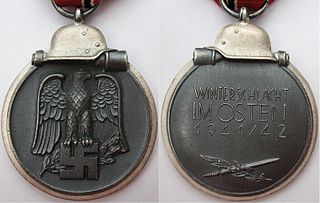
The Eastern Medal, officially the Winter Battle in the East 1941–42 Medal, was a military award of the Wehrmacht which was created by ordinance of Adolf Hitler on 26 May 1942.

The Spanish Cross was an award of Nazi Germany given to German troops who participated in the Spanish Civil War, fighting for nationalist general, later Spanish caudillo, Francisco Franco.
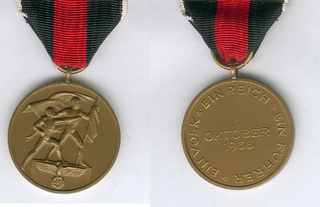
The 1 October 1938 Commemorative Medal, commonly known as the Sudetenland Medal was a decoration of Nazi Germany awarded during the interwar period, and the second in a series of Occupation Medals.
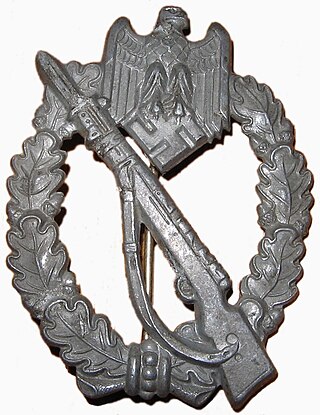
The Infantry Assault Badge was a German military decoration awarded to Waffen-SS and Wehrmacht Heer soldiers during the Second World War. This decoration was instituted on 20 December 1939 by the Commander-in-Chief (Oberbefehlshaber) of the German Army, Generalfeldmarschall Walther von Brauchitsch. It could be awarded to members of infantry and Gebirgsjäger units that had participated in infantry assaults, with light infantry weapons, on at least three separate days of battle in the front line on or after 1 January 1940. When a counter-offensive led to fighting, it could also apply. Award of the Infantry Assault Badge was authorized at regimental command level, and mechanized or motorized infantry were not eligible for the original badge. A bronze variant of the Infantry Assault Badge was created in June 1940, authorized for motorized and mechanized infantry units, using similar requirements for award as the original silver variant. Non-infantry personnel were not eligible for either grade of the Infantry Assault Badge, but were eligible for other combat recognition badges, usually the General Assault Badge, Close Combat Clasp, or the Panzer Badge. The Luftwaffe would develop its own ground combat badge in 1942, the Ground Assault Badge.
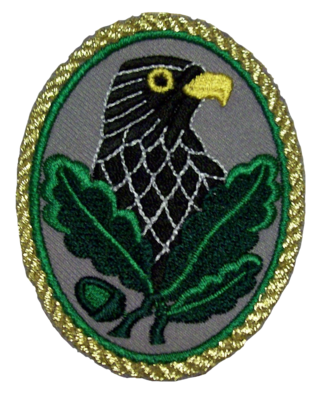
The Sniper's Badge was a World War II German military decoration awarded to snipers. It was instituted on 20 August 1944. Initially, only personnel serving in the German Army and the Waffen-SS were eligible. Later, by order of the High Command, it was also made available to snipers of the other armed services.

The Close Combat Clasp was a World War II German military award instituted on 25 November 1942 for participation in hand-to-hand fighting at close quarters. Intended primarily for infantry, other Wehrmacht, Waffen-SS, ground Luftwaffe units and paratroopers were also eligible.
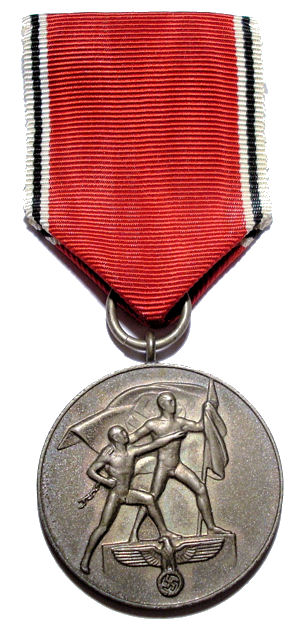
The Anschluss Commemorative Medal was a decoration of Nazi Germany awarded during the interwar period, and the first in a series of Occupation Medals.
The Danzig Cross was a Nazi decoration of the Free City of Danzig. The Cross was instituted on 31 August 1939 as a two grade decoration by Danzig Gauleiter Albert Forster. It was awarded to those, both in Danzig and in the wider Reich, who contributed to building up the Nazi Party in the Free City prior to its incorporation into Germany on 1 September 1939.

The Combat Action Medal of the Bundeswehr is a military decoration awarded by the German Bundeswehr. The medal is awarded for active participation in combat actions or for the suffering from terrorist attacks. It is awarded only once and, if the recipient was killed in action, posthumously.
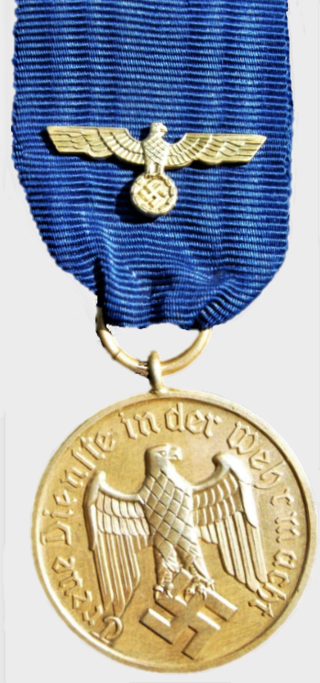
The Wehrmacht Long Service Award was a military service decoration of Nazi Germany issued for satisfactory completion of a number of years in military service.
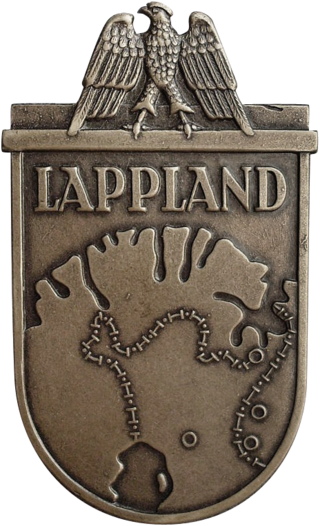
The Lapland Shield was a World War II German military decoration awarded to military personnel of General Franz Böhme’s 20th Mountain Army which fought a two-front campaign against advancing Finnish and Soviet Red Army forces in Lapland between November 1944 and the war’s end in May 1945. It was awarded to men who had "honorably served" for six months in the region or had been wounded during operations there. It was authorized in February 1945 and was the last officially instituted German campaign shield of the war.

The Crete Cuff Title, or Crete Cuff Band, was a World War II German military decoration awarded to Wehrmacht servicemen who took part in the battle of Crete between 20 and 27 May 1941.

The Africa Cuff Title, or Africa Cuff Band, was a World War II German military decoration awarded to members of the Wehrmacht who took part in the North African campaign of 1941–43.
The Metz 1944 Cuff Title, or Metz 1944 Cuff Band, was a World War II German military decoration instituted to reward members of the Wehrmacht who took part in the 1944 battle of Metz.

The Courland Cuff Title, or Courland Cuff Band, was a World War II German military decoration awarded to Wehrmacht servicemen of Army Group Courland who served in the Courland Pocket.

The Warsaw Shield,, or Warsaw Arm Shield, was a planned World War II German military decoration intended for award to Wehrmacht and Waffen-SS servicemen who took part in the suppression of the 1944 Warsaw uprising. Although authorised, with the conditions of award and the design approved and announced, production had not begun prior to the end of the war and the award was never issued.

The Driver Proficiency Badge was a German military badge awarded to drivers of military transport vehicles during World War II.























